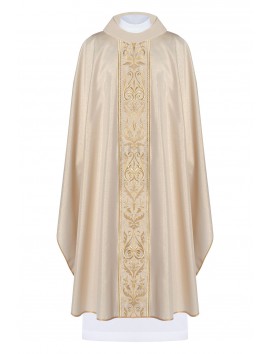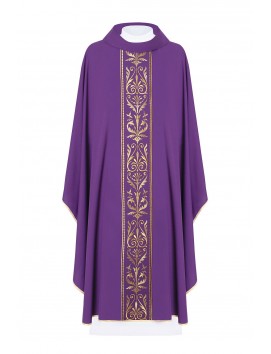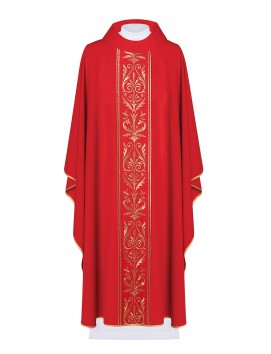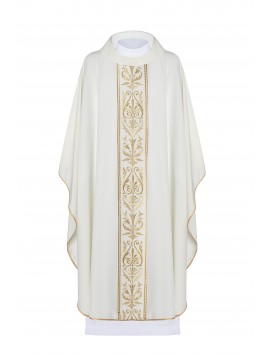During Lent, the liturgical color for the vestments worn by Catholic priests is purple. Purple symbolizes penance, humility, and sorrow for sins. It is also a color of preparation, since Lent is a season of spiritual renewal and conversion, preparing for the celebration of Easter.
The use of purple vestments during Lent dates back to the early Christian church, when penitents wore sackcloth and ashes as a sign of repentance. Over time, the use of purple became associated with this time of repentance and preparation.
In addition to purple, some churches may use rose or pink vestments on the Fourth Sunday of Lent, also known as Laetare Sunday. This is a day of joy and anticipation of Easter, and the rose or pink color symbolizes this joy and hope.

What color vestment does the priest wear on Easter sunday?
On Easter Sunday, the liturgical color for the vestments worn by Catholic priests is white or gold. These colors symbolize joy, purity, and glory. White is often associated with the resurrection of Jesus Christ and signifies new life and the triumph of light over darkness. Gold, on the other hand, represents the glory of God and the majesty of the risen Christ.
Easter is the most important feast in the Christian calendar, and the use of white or gold vestments reflects the significance and solemnity of this celebration. The white or gold vestments are often decorated with intricate designs or embroidery to further emphasize the joy and grandeur of Easter. In some traditions, the priest may also wear a white cope or dalmatic with gold trim to complete the festive attire.
What color vestments do priests wear on Palm Sunday?
On Palm Sunday, the liturgical color for the vestments worn by Catholic priests is red. This color symbolizes the passion and sacrifice of Jesus Christ, who rode into Jerusalem on a donkey as people waved palm branches and shouted "Hosanna! Red is also associated with blood and martyrdom, as Jesus would later shed his blood on the cross for the salvation of mankind. Palm Sunday marks the beginning of Holy Week, the most solemn and important week in the Christian calendar. The use of red vestments on this day emphasizes the seriousness and gravity of the events that will follow in the coming days, including the Last Supper, the Crucifixion, and the Resurrection.
What color vestments do priests wear on pentecost?
At Pentecost, the liturgical color for the vestments worn by Catholic priests is red. This color symbolizes the fire of the Holy Spirit that descended upon the apostles and disciples of Jesus Christ, as described in the Bible. Red is also associated with courage, passion, and zeal, qualities that the Holy Spirit imparts to believers. Pentecost is an important feast in the Christian calendar, marking the birth of the church and the beginning of its mission to spread the gospel to all nations. The use of red robes on this day emphasizes the importance of the Holy Spirit as the source of spiritual strength and inspiration for Christians. The red vestments are often decorated with intricate designs or embroidery to further emphasize the joy and significance of Pentecost.
Why do catholic priests wear different color vestments?
Catholic priests wear different colored vestments to indicate the liturgical season or occasion and to express the themes and moods of the particular liturgical celebration. The use of liturgical colors dates back to early Christianity and has evolved into a complex system of symbolism and meaning.
The principal liturgical colors used in the Catholic Church are
1. White - symbolizes purity, joy and light. It is used for the seasons of Christmas and Easter, as well as for feasts and celebrations of the Lord, the Blessed Virgin Mary, and the saints.
2. Red - symbolizes the fire of the Holy Spirit, blood and martyrdom. It is used for Pentecost, Good Friday, and the feasts of the apostles and martyrs.
3. Green - symbolizes growth and hope. It is used during Ordinary Time, the longest liturgical season in the Catholic Church.
4. Violet/Purple - symbolizes penance, preparation and waiting. It is used during Advent and Lent, the seasons of repentance and fasting.
When do priests wear blue vestments?
Blue vestments are not commonly used in the Catholic Church. In fact, blue is not an official liturgical color. There are, however, some exceptions to this rule. In some regions, such as Mexico and parts of Spain, blue vestments may be used on the Feast of the Immaculate Conception, which is celebrated on December 8. This is because the color blue is associated with the Virgin Mary, who is honored on this day as the sinless mother of Jesus. Blue is also sometimes used as an alternative to purple during Advent. However, this use of blue is not officially sanctioned by the Church. It is important to note that the use of liturgical colors may vary according to local customs and traditions, but the official liturgical colors recognized by the Catholic Church are white, red, green, purple, and black.
When do priests wear red vestments?
Priests wear red vestments on certain liturgical occasions to symbolize the fire of the Holy Spirit, blood, and martyrdom. Here are some examples of when red vestments are worn:
1. Pentecost: On this day, which falls 50 days after Easter, the Church celebrates the coming of the Holy Spirit upon the apostles and the birth of the Church. Red vestments are worn to symbolize the tongues of fire that appeared over the heads of the apostles.
2. Good Friday: Red vestments may be worn on Good Friday, which commemorates the crucifixion and death of Jesus, to symbolize His shed blood.
3. Feasts of Martyrs: Red vestments are worn on the feasts of martyrs, who are honored for their witness to the point of shedding their blood.
4. Other occasions: Red vestments may also be worn on certain occasions, such as the installation of a bishop or the ordination of a priest.




















